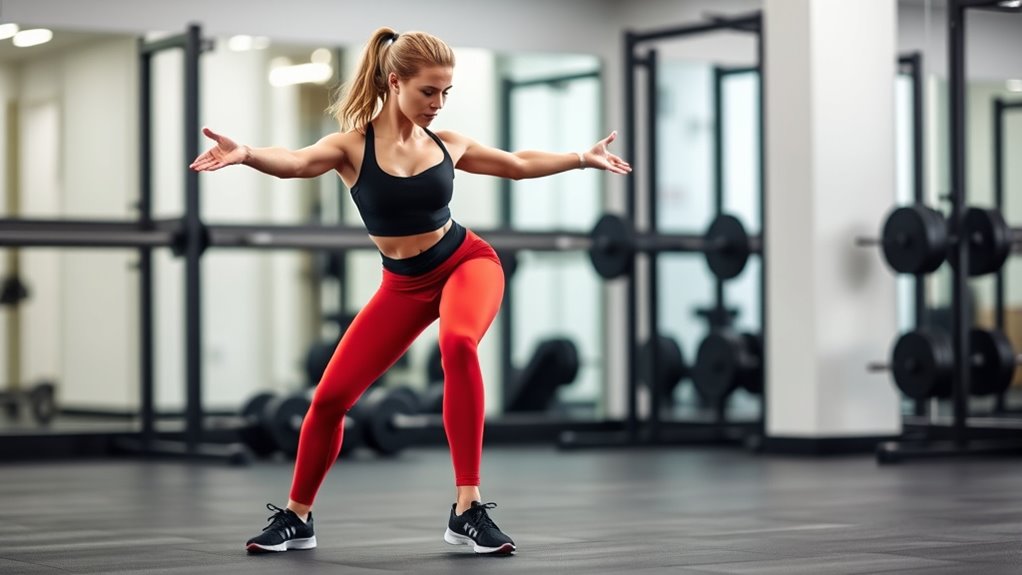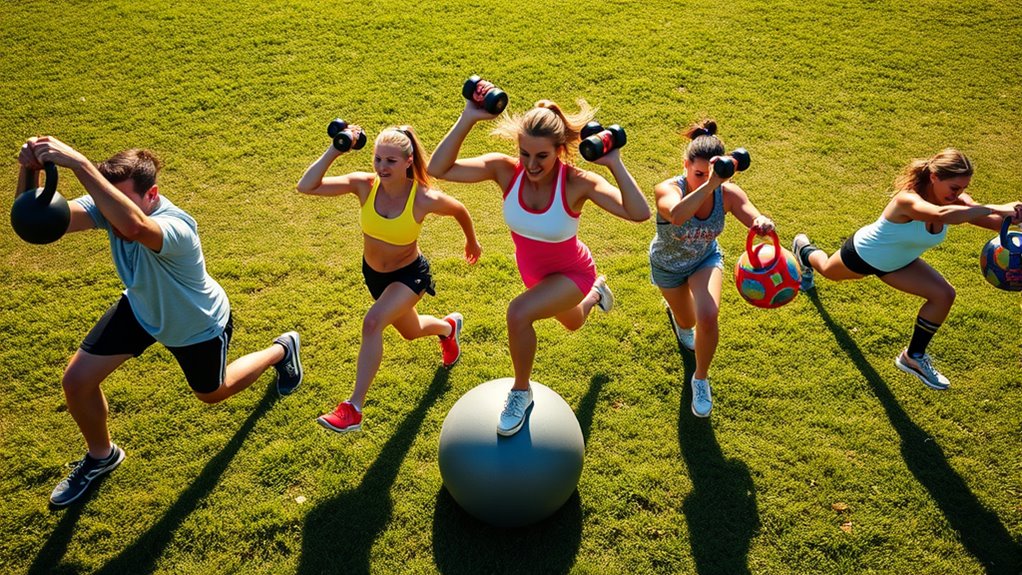To boost your softball strength and conditioning, focus on exercises like plyometric box jumps to improve explosive power and leg strength, and medicine ball rotational throws to build rotational core power for swinging and throwing. Incorporate single-leg deadlifts to enhance stability and hamstring strength, sprint intervals for quickness and endurance, and plank variations to develop a strong, stable core. Keep going to discover how each of these exercises can elevate your game even further.
Key Takeaways
- Incorporate plyometric box jumps to develop explosive power and improve overall athleticism.
- Use medicine ball rotational throws to enhance core strength and rotational torque for better swings and throws.
- Perform single-leg deadlifts to boost balance, stability, and posterior chain strength critical for fielding and sprinting.
- Include sprint intervals to increase quickness, acceleration, and endurance on the field.
- Add various plank exercises to strengthen core stability, supporting overall athletic performance and injury prevention.
Plyometric Box Jumps

Plyometric box jumps are essential for building explosive power and improving your overall athletic performance in softball. This jump training exercise helps you develop the leg strength and quickness needed for powerful swings, fast base running, and agile fielding. When you perform box jumps, you train your muscles to generate maximum force in a short period, boosting your explosiveness. Start with a sturdy box that matches your fitness level, and focus on jumping onto it with controlled, powerful movements. Land softly to absorb impact and immediately jump back down. Incorporating proper training techniques can enhance your results and help prevent injuries. Incorporate this exercise into your routine two to three times a week to see improvements in your jump height, speed, and overall athleticism. Plyometric box jumps are a key component of effective softball conditioning.
Medicine Ball Rotational Throws

Medicine ball rotational throws are a highly effective exercise for developing rotational power and core strength, which are essential for swinging and throwing in softball. This move targets your obliques, abdominals, and back muscles, enhancing your core stabilization. To perform, stand with your feet shoulder-width apart, hold a medicine ball at your waist, and rotate your torso explosively, throwing the ball against a wall or to a partner. Catch it on the rebound and repeat. Focus on controlled, powerful rotations, engaging your core throughout each throw. Incorporating medicine ball rotational throws into your training routine improves your ability to generate torque during swings and throws, making you more explosive and stable on the field. Proper technique guarantees maximum results and reduces injury risk.
Single-Leg Deadlifts

Single-leg deadlifts are a powerful exercise for building balance, stability, and posterior chain strength, all of which are essential for a softball player’s performance. This move challenges your balance training by forcing you to stabilize on one leg, improving coordination and proprioception. As you hinge at the hips, you activate your hamstrings, glutes, and lower back, enhancing overall strength and flexibility. Incorporating single-leg deadlifts into your routine helps prevent injuries and boosts your athleticism on the field. Focus on controlled movements to maximize benefits and maintain proper form. Regular practice also increases flexibility, especially in your hamstrings and hips, which can improve your range of motion during dives, swings, and quick directional changes. Overall, this exercise is a versatile addition to your conditioning plan.
Sprint Intervals

Have you ever wondered how to boost your quickness and endurance on the field? Sprint intervals are a game-changer for softball players. They enhance agility drills and push your endurance training to the next level. To get started, focus on these steps:
- Warm up with light jogging to prepare your muscles.
- Sprint at maximum effort for 20-30 seconds, pushing your speed.
- Rest for 60 seconds to recover fully.
- Repeat the cycle 6-8 times for ideal results.
- Incorporating Kia Tuning techniques can also improve your overall athletic performance by optimizing your training gear and strategies.
This high-intensity approach improves your ability to accelerate quickly and sustain energy during long innings. Incorporating sprint intervals regularly will sharpen your agility on the bases and strengthen your overall endurance, giving you a competitive edge on the field.
Plank Variations

Adding variety to your core workouts can substantially boost your overall strength and stability. Plank variations are excellent for enhancing core stability and muscle endurance, essential for softball players. Switching between different types challenges your muscles differently, preventing plateaus and keeping workouts engaging. Try side planks, forearm planks, or plank with leg lifts to target various core muscles. These variations improve balance, stability, and overall athletic performance. Incorporate these into your routine to build a stronger, more resilient core. Here’s a quick overview:
| Plank Type | Focus Area | Benefits |
|---|---|---|
| Forearm Plank | Core stability | Builds endurance, stability |
| Side Plank | Obliques, shoulder stability | Improves balance |
| Plank with Leg Lift | Lower back, glutes | Enhances muscle endurance |
| Reverse Plank | Posterior chain | Strengthens back, shoulders |
| Walking Plank | Full core, shoulder stability | Dynamic core activation |
Frequently Asked Questions
How Often Should I Perform These Exercises Weekly?
You should aim for exercise frequency that balances training and recovery, typically working out 3 to 4 times a week. This helps optimize strength gains and injury prevention without overtraining. Consistent workouts strengthen muscles, improve flexibility, and reduce injury risk. Make sure to include rest days to allow recovery. Listening to your body is key—if you feel sore or fatigued, give yourself extra rest to stay injury-free and perform your best.
Can Beginners Safely Do These Exercises Without Injury?
You can definitely do these exercises safely as a beginner by focusing on proper form and listening to your body. Injury prevention is key, so start with lighter weights or easier modifications. Gradually increase intensity, and don’t push through pain. If you’re unsure, consider working with a trainer for guidance. Prioritizing beginner safety helps you build strength effectively while minimizing injury risks.
What Equipment Is Essential for These Workouts?
When planning your workout routines, you’ll find that a few essential training accessories can make a big difference. You’ll need items like resistance bands, dumbbells, and a stability ball to enhance your exercises. These pieces of equipment support your training, improve strength, and help prevent injury. Keep your routines safe and effective by investing in the right gear, making sure you’re well-equipped for progress and consistency in your softball training.
How Do These Exercises Improve Softball Performance?
Think of your body as a finely tuned machine; these exercises act as the oil that keeps it running smoothly. By doing dynamic stretching, you prepare your muscles for action, like warming up a car engine. Core stability exercises strengthen your foundation, enabling powerful throws and swift movements. Together, they enhance your agility, speed, and endurance, helping you perform better on the field and stay injury-free.
Are There Any Common Mistakes to Avoid During These Exercises?
When doing these exercises, you should focus on proper form technique to prevent common mistakes. Always maintain correct posture, control your movements, and don’t rush through reps. This helps ensure injury prevention and maximizes benefits. Avoid using momentum or sacrificing technique for heavier weights. Listening to your body and seeking guidance when unsure also helps prevent strain or injury, keeping your training safe and effective.
Conclusion
Incorporate these top 5 exercises into your routine, and you’ll build the strength and agility needed to excel on the field. Consistency is key—remember, practice makes perfect. Stay committed, push your limits, and you’ll see progress. As the saying goes, “Rome wasn’t built in a day,” so be patient and keep working hard. With dedication and the right exercises, you’ll elevate your softball game to new heights.









